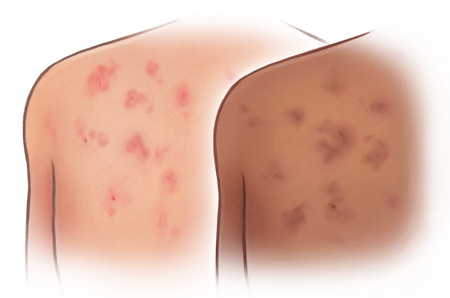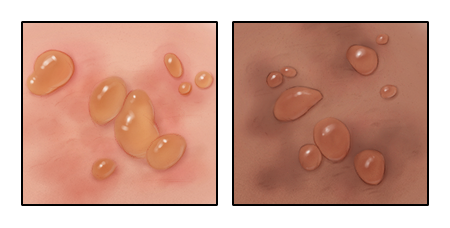This information explains what bullous pemphigoid is and how to treat it.
Bullous pemphigoid (BUL-us PEM-fih-goid) is a rare skin condition. It causes large fluid-filled blisters to form on your skin. They often start on areas of your skin that flex (bend). These areas include your arms, armpits, legs, lower abdomen (belly), and groin (the area between your belly and thigh).
Who gets bullous pemphigoid?
Bullous pemphigoid is most common in older females, age 70 and older. It’s not as common in males, younger adults, and children.
Some people who are pregnant can get bullous pemphigoid. This is called gestational pemphigoid. Your dermatologist (skin doctor) and obstetrician (doctor with special training in pregnancy and childbirth) will work together with you to help you manage it.
Bullous pemphigoid is not contagious (cannot spread from person to person). This means you can’t catch it from someone who has it.
What causes bullous pemphigoid?
We don’t know what causes bullous pemphigoid. But we do know that it starts when your body’s immune system (your body’s defense against infection) makes antibodies (proteins) that attack healthy cells. This is called an autoimmune response.
Your antibodies attack the membrane between the outer layer of your skin (epidermis) and the layer under it (dermis). This attack causes fluid to build up and form between these 2 layers of your skin.
Certain things have been linked to bullous pemphigoid, but we don’t think they cause it. They include:
-
Diseases, such as:
- Ulcerative colitis (sores in your colon).
- Multiple sclerosis (a disease that affects your central nervous system).
-
Medications, such as:
- Furosemide (reduces extra fluid in your body).
- Non-steroidal anti-inflammatory drugs (NSAIDs).
- Captopril (treats high blood pressure).
- Penicillamine (treats rheumatoid arthritis).
- Some antibiotics (drugs that kill bacteria).
- Ultraviolet radiation and radiotherapy
What are the symptoms of bullous pemphigoid?
The most common symptom of bullous pemphigoid is small patches of itchy skin. This is usually the first symptom.
You may also get a pink-colored rash (see Figure 1) that looks like eczema (skin rash).
Some people may get blisters after a week or more (see Figure 2), while others may get blisters months later. These blisters are often itchy, but not painful. They’re mostly firm and dome shaped.
The fluid inside the blisters is usually clear but can also be cloudy or have a little blood in it. The skin around your blisters may look normal, darker than normal, or red.


Where do bullous pemphigoid blisters appear on your skin?
Any area of your skin can be affected, but blisters often appear on your:
- Arms.
- Armpits.
- Legs.
- Lower abdomen (belly).
- Groin (the area between your belly and thigh).
There may be more blisters on certain parts of your body than others, such as your lower leg. In severe (very bad) cases, your whole body may be affected.
Some people may get small blisters inside their mouth. These blisters can open and look like mouth ulcers.
How long do bullous pemphigoid blisters last? Do they heal on their own?
The skin over your blisters is very strong. Because of this, it can take a few days for your blister to burst (open). After your blister bursts, a raw patch of skin is left. This patch of skin will heal within 7 to 10 days.
Some blisters do not burst. Instead, the fluid is absorbed into your body and the top of the blister settles back down on your skin. These kinds of blisters often heal without forming scars.
Bullous pemphigoid can last from 1 to 5 years. If untreated, the blisters and open areas of your skin can cause pain and discomfort. You may also get a severe infection in the open areas of your skin.
How is bullous pemphigoid diagnosed?
If your healthcare provider suspects that you have bullous pemphigoid, they will send you to a dermatologist. These tests are done to confirm your diagnosis:
- A biopsy. This is a procedure to take a tissue sample. The sample is looked at under a microscope and tested to confirm bullous pemphigoid caused the blisters.
- A blood test. This can find the antibody that causes bullous pemphigoid. The antibody can also be found in your urine (pee) or blister fluid.
What is the treatment for bullous pemphigoid?
Treatment slows down your autoimmune response. This will stop itching and reduce blisters. It’s important to find the right treatment so you feel comfortable. The goal of treatment is to treat symptoms without causing too many side effects. This often happens when symptoms are not severe.
Based on how severe your skin condition is, treatment can last anywhere from 6 months to 5 years.
Treatment includes:
Steroid creams
Steroid creams are safe to use and work well in treating bullous pemphigoid. High-dose steroid creams, such as Clobetasol (Dermovate™), are used to treat severe symptoms.
Steroid tablets
If you cannot use steroid cream, you can use steroid tablets to treat bullous pemphigoid. Steroid tablets, such as prednisone, are often used when a rash has spread throughout your body.
Steroid tablets reduce swelling and control your autoimmune response. Your steroid dose depends on how severe your bullous pemphigoid is. A medium or high dose usually is needed at first. Your dose can be lowered once your blisters clear up.
The goal is to find the lowest dose needed to control your symptoms. The dosage will be different for everybody. Your healthcare provider will talk with you about what dose is right for you.
Using steroid creams and tablets together
Steroid creams and tablets can be used together to treat bullous pemphigoid. You may be able to take a lower dose of steroid tablets. Talk with your healthcare provider about using steroid creams and tablets together.
What are the side effects of steroid creams and tablets?
You may have side effects when using steroid creams or taking steroid tablets. Side effects can include:
- Infection.
- Osteoporosis (thinning of your bones).
- Trouble sleeping.
- Weight gain.
- Skin that is thinning, bruising, or tearing.
- Wounds that heal slower than normal.
- Stomach ulcers.
- Hypertension (high blood pressure).
If you take steroids for more than a month, your healthcare provider will have you take vitamin D and calcium tablets. Taking these will help prevent osteoporosis.
Do not stop long-term steroid treatment suddenly. Stopping treatment may cause your symptoms to return and you may feel sick.
Side effects can be serious if you take a high dose of steroids for a long time. If you start having side effects, make sure to contact your healthcare provider right away. Talk with them about your symptoms and to re-evaluate your treatment plan.
If steroid creams and tablets don’t work, are there other treatments for bullous pemphigoid?
Your healthcare provider may also suggest applying dressings. They will tell you how to care for your open skin.
If steroids don’t help your symptoms, your healthcare provider may treat you with other medications. They include Dapsone, Sulfonamides (BactrimTM), or Rituximab (Rituxan ®) for more severe cases. These medications are not used as often because they have more side effects.
Does bullous pemphigoid ever go away?
With treatment, bullous pemphigoid often goes away in 1 to 5 years. It’s possible to get it again, but it’s usually less severe.
It’s important to contact your dermatologist if you have:
- Blister that come and go.
- Itching all over your body.
- Infection of open skin.
- Other symptoms of bullous pemphigoid.